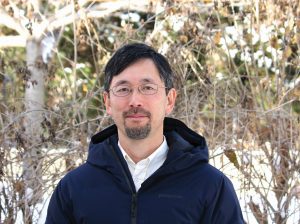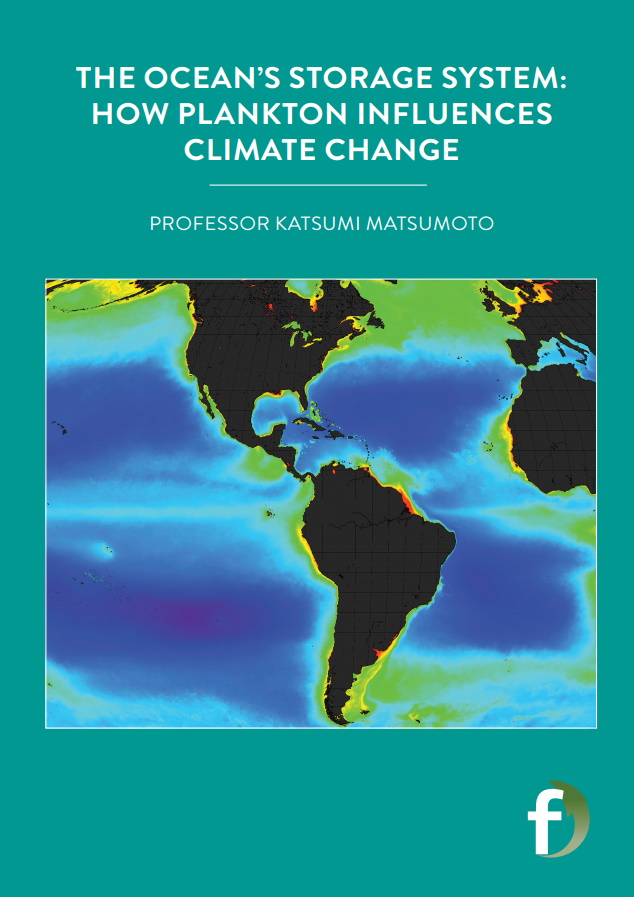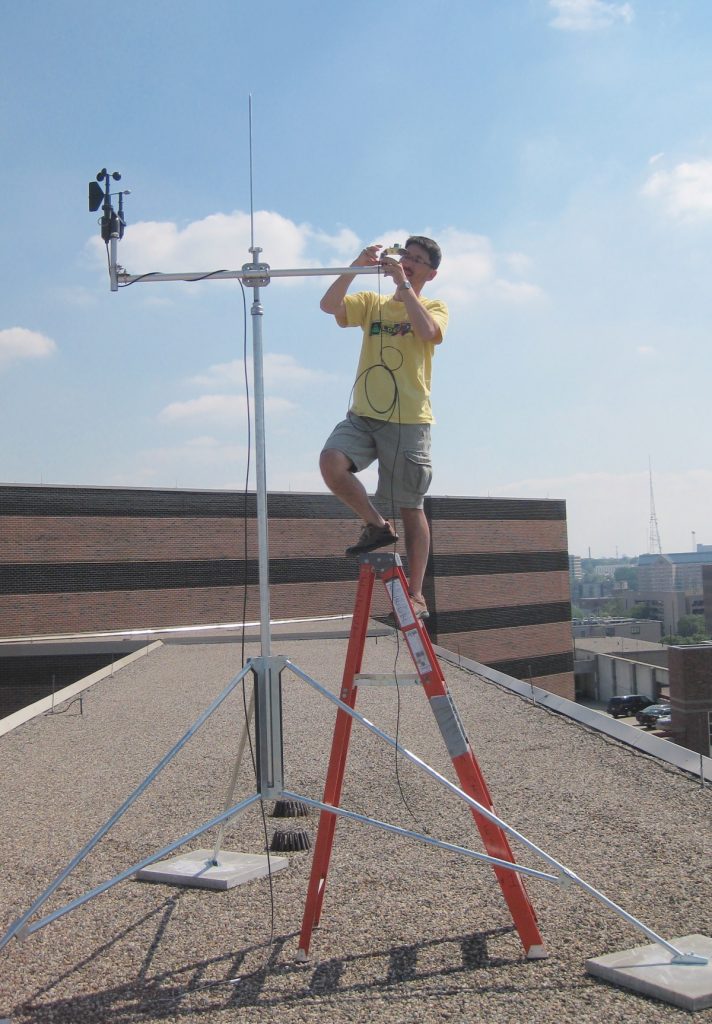The ocean’s storage system: how plankton influences climate change
The ocean has an incredible capacity to store carbon. It has been absorbing one third of humanity’s emissions over the last century or two, and ultimately will absorb much of our future emissions. Phytoplankton communities play a key role in the ocean carbon cycle, as carbon is removed from the atmosphere and transferred to the deep ocean for long-term storage. Professor Katsumi Matsumoto of the University of Minnesota in the US uses computer models to understand this process, and what it means for global climate change
TALK LIKE AN OCEAN BIOGEOCHEMIST
BIOLOGICAL PUMP – the ocean’s biologically driven capture and sequestration of carbon from the atmosphere
CARBON CYCLE – the group of processes that involve converting carbon compounds from one form to another, such as photosynthesis, respiration, decay, and combustion
CARBON SEQUESTRATION – the process of capturing and storing atmospheric carbon dioxide
PHOTOSYNTHESIS – the chemical process by which plants convert carbon dioxide, water and light into organic molecules
PHYTOPLANKTON – microscopic marine plants that inhabit the ocean’s surface waters
TAXONOMY – the system of classifying organisms
While humanity is busy pumping carbon into the atmosphere, the ocean is busy absorbing it. Carbon dioxide is soluble in seawater, and from here it can enter living organisms. Phytoplankton – microscopic marine plants – live near the ocean’s surface and incorporate carbon into their cells via photosynthesis. Through death or other food chain processes, some of this carbon ultimately sinks into the deep ocean where it is stored in seawater and ocean floor sediments. In this way, the ocean acts as a vitally important carbon store, significantly slowing the rate of climate change.
This effect is known as the ‘biological pump’. “The biological pump is the vertical transfer of photosynthesis-derived organic matter from the surface ocean to the deep ocean,” says Professor Katsumi Matsumoto of the University of Minnesota. “This means that carbon dioxide from the atmosphere is moved to deep waters where it can be sequestered for centuries or more. The stronger the biological pump, the more it cools the global climate through lower atmospheric carbon dioxide.”
However, the rate at which this happens is partly determined by the phytoplankton communities involved. Depending on environmental conditions, these phytoplankton communities can vary considerably, which affects their role in the global ocean carbon cycle. Katsumi works in the field of ocean biogeochemistry and uses computer models to predict the growth of these microscopic organisms and their influence on the carbon cycle at the global scale.
PHYTOPLANKTON
“All life forms grow using the same basic elemental ingredients, which include carbon (C), nitrogen (N) and phosphorous (P),” says Katsumi. “Carbon is the basic building block of cells, nitrogen is a major component of proteins, and phosphorous is essential for nucleic acids such as DNA.” Katsumi studies the C:N:P ratio of phytoplankton – in other words, how and why the proportions of these three elements vary within these organisms.
This work involves challenging a historical precedent. “Almost a century ago, Alfred Redfield observed that the C:N:P ratio in marine plankton was stable and very similar to the C:N:P ratio of seawater. This observation became known as the ‘Redfield ratio’ and is a central idea in biological and chemical oceanography,” says Katsumi. “However, recent work shows that this C:N:P ratio in plankton can actually vary considerably. The goal of my project is to find a way of incorporating this variability into ocean models and use these models to explore the impacts of these variations on the ocean carbon cycle and the global climate.”
INFLUENCES ON THE C:N:P RATIO
“In general terms, the strength of the biological pump is often limited by the availability of nutrients,” says Katsumi. “Just as garden plants grow more when fertilised with N and P, so do marine phytoplankton.” However, research is revealing this is an overly simplistic explanation, because it assumes the C:N:P ratio remains constant and follows the Redfield ratio. Real life, as is often the case, is significantly more complicated.
My research has identified three broad factors that determine the C:N:P ratio in phytoplankton at different scales,” says Katsumi. “For individual cells, the C:N:P ratio is determined by the availability of N and P, temperature, and light level. For instance, when P is scarce in surrounding seawater, cells will compensate and become C-rich, and use P only frugally.” Yet the plot thickens, because different phytoplankton species respond to these environmental factors in different ways. “Taxonomy is therefore the second broad factor affecting the C:N:P ratio. For example, cyanobacteria are an especially C-rich type of phytoplankton, so communities where these species dominate will have a high C:N:P ratio.” The effects of these different species on the global biological pump depends on how abundant they are across the world – places with a high ‘productivity’ (i.e. lots of phytoplankton present) will make a greater contribution to the global production than low-productivity areas. “Thus, the three controls are physiological, taxonomic, and productivity,” concludes Katsumi.
BUILDING THE RATIO INTO MODELS
“Numerical models of the ocean are mathematical representations of how the real ocean works,” says Katsumi. “For example, winds will push surface ocean waters and generate ocean currents, and there are equations that express this wind-current relationship.” Physical and chemical processes are generally easier to model, because the fundamental ‘laws’ governing how they work are better understood. Biological processes on the other hand, such as phytoplankton productivity, are more complex and can end up being over-simplified in models. Katsumi is working on changing that. “Many equations of biological processes are based on observations,” he says. “I study the results of observational investigations of ocean biogeochemistry and try to distil them into simple equations, which I then incorporate into my models.”
Currently, the Redfield ratio is used widely to model ocean behaviour such as the carbon cycle, but as has been seen, this isn’t always an accurate representation. Now, oceanographers can use Katsumi’s models within their own models, to give a more true-to-life picture of the global ocean. “My work allows scientists to estimate how the C:N:P ratio of phytoplankton varies according to different environmental conditions,” says Katsumi. “This in turn can lead to more accurate models for estimating what climates were like in the distant past, and the ocean’s responses to current and future climate change.”
DISCOVERIES
Ongoing global warming is leading to an effect in the ocean known as thermal stratification, which means that the ‘layers’ of water at different depths are mixing less than before. Most significantly, this means that nutrients held in deeper layers are less likely to be brought to surface waters, meaning that the phytoplankton’s environment has less N and P available. Based on the Redfield ratio alone, this is expected to significantly weaken the biological pump, because without available N or P, the phytoplankton cannot capture C.
However, Katsumi’s research reveals that this may be partially offset by the other factors he has investigated that affect the C:N:P ratio. “Low nutrient levels elevate the C:N:P ratio in cells, meaning they capture proportionally more C than N or P,” says Katsumi. “At the same time, decreasing nutrients and increasing temperatures favour communities of C-rich phytoplankton species, such as cyanobacteria.” These physiological and taxonomic responses mean that, although the biological pump will still weaken considerably by the end of the century, it could weaken by 30% less than might be expected without this information under a standard future warming scenario.
Reference
https://doi.org/10.33424/FUTURUM148
BIOLOGICAL PUMP – the ocean’s biologically driven capture and sequestration of carbon from the atmosphere
CARBON CYCLE – the group of processes that involve converting carbon compounds from one form to another, such as photosynthesis, respiration, decay, and combustion
CARBON SEQUESTRATION – the process of capturing and storing atmospheric carbon dioxide
PHOTOSYNTHESIS – the chemical process by which plants convert carbon dioxide, water and light into organic molecules
PHYTOPLANKTON – microscopic marine plants that inhabit the ocean’s surface waters
TAXONOMY – the system of classifying organisms
While humanity is busy pumping carbon into the atmosphere, the ocean is busy absorbing it. Carbon dioxide is soluble in seawater, and from here it can enter living organisms. Phytoplankton – microscopic marine plants – live near the ocean’s surface and incorporate carbon into their cells via photosynthesis. Through death or other food chain processes, some of this carbon ultimately sinks into the deep ocean where it is stored in seawater and ocean floor sediments. In this way, the ocean acts as a vitally important carbon store, significantly slowing the rate of climate change.
This effect is known as the ‘biological pump’. “The biological pump is the vertical transfer of photosynthesis-derived organic matter from the surface ocean to the deep ocean,” says Professor Katsumi Matsumoto of the University of Minnesota. “This means that carbon dioxide from the atmosphere is moved to deep waters where it can be sequestered for centuries or more. The stronger the biological pump, the more it cools the global climate through lower atmospheric carbon dioxide.”
However, the rate at which this happens is partly determined by the phytoplankton communities involved. Depending on environmental conditions, these phytoplankton communities can vary considerably, which affects their role in the global ocean carbon cycle. Katsumi works in the field of ocean biogeochemistry and uses computer models to predict the growth of these microscopic organisms and their influence on the carbon cycle at the global scale.
PHYTOPLANKTON
“All life forms grow using the same basic elemental ingredients, which include carbon (C), nitrogen (N) and phosphorous (P),” says Katsumi. “Carbon is the basic building block of cells, nitrogen is a major component of proteins, and phosphorous is essential for nucleic acids such as DNA.” Katsumi studies the C:N:P ratio of phytoplankton – in other words, how and why the proportions of these three elements vary within these organisms.
This work involves challenging a historical precedent. “Almost a century ago, Alfred Redfield observed that the C:N:P ratio in marine plankton was stable and very similar to the C:N:P ratio of seawater. This observation became known as the ‘Redfield ratio’ and is a central idea in biological and chemical oceanography,” says Katsumi. “However, recent work shows that this C:N:P ratio in plankton can actually vary considerably. The goal of my project is to find a way of incorporating this variability into ocean models and use these models to explore the impacts of these variations on the ocean carbon cycle and the global climate.”
INFLUENCES ON THE C:N:P RATIO
“In general terms, the strength of the biological pump is often limited by the availability of nutrients,” says Katsumi. “Just as garden plants grow more when fertilised with N and P, so do marine phytoplankton.” However, research is revealing this is an overly simplistic explanation, because it assumes the C:N:P ratio remains constant and follows the Redfield ratio. Real life, as is often the case, is significantly more complicated.
My research has identified three broad factors that determine the C:N:P ratio in phytoplankton at different scales,” says Katsumi. “For individual cells, the C:N:P ratio is determined by the availability of N and P, temperature, and light level. For instance, when P is scarce in surrounding seawater, cells will compensate and become C-rich, and use P only frugally.” Yet the plot thickens, because different phytoplankton species respond to these environmental factors in different ways. “Taxonomy is therefore the second broad factor affecting the C:N:P ratio. For example, cyanobacteria are an especially C-rich type of phytoplankton, so communities where these species dominate will have a high C:N:P ratio.” The effects of these different species on the global biological pump depends on how abundant they are across the world – places with a high ‘productivity’ (i.e. lots of phytoplankton present) will make a greater contribution to the global production than low-productivity areas. “Thus, the three controls are physiological, taxonomic, and productivity,” concludes Katsumi.
BUILDING THE RATIO INTO MODELS
“Numerical models of the ocean are mathematical representations of how the real ocean works,” says Katsumi. “For example, winds will push surface ocean waters and generate ocean currents, and there are equations that express this wind-current relationship.” Physical and chemical processes are generally easier to model, because the fundamental ‘laws’ governing how they work are better understood. Biological processes on the other hand, such as phytoplankton productivity, are more complex and can end up being over-simplified in models. Katsumi is working on changing that. “Many equations of biological processes are based on observations,” he says. “I study the results of observational investigations of ocean biogeochemistry and try to distil them into simple equations, which I then incorporate into my models.”
Currently, the Redfield ratio is used widely to model ocean behaviour such as the carbon cycle, but as has been seen, this isn’t always an accurate representation. Now, oceanographers can use Katsumi’s models within their own models, to give a more true-to-life picture of the global ocean. “My work allows scientists to estimate how the C:N:P ratio of phytoplankton varies according to different environmental conditions,” says Katsumi. “This in turn can lead to more accurate models for estimating what climates were like in the distant past, and the ocean’s responses to current and future climate change.”
DISCOVERIES
Ongoing global warming is leading to an effect in the ocean known as thermal stratification, which means that the ‘layers’ of water at different depths are mixing less than before. Most significantly, this means that nutrients held in deeper layers are less likely to be brought to surface waters, meaning that the phytoplankton’s environment has less N and P available. Based on the Redfield ratio alone, this is expected to significantly weaken the biological pump, because without available N or P, the phytoplankton cannot capture C.
However, Katsumi’s research reveals that this may be partially offset by the other factors he has investigated that affect the C:N:P ratio. “Low nutrient levels elevate the C:N:P ratio in cells, meaning they capture proportionally more C than N or P,” says Katsumi. “At the same time, decreasing nutrients and increasing temperatures favour communities of C-rich phytoplankton species, such as cyanobacteria.” These physiological and taxonomic responses mean that, although the biological pump will still weaken considerably by the end of the century, it could weaken by 30% less than might be expected without this information under a standard future warming scenario.
 PROFESSOR KATSUMI MATSUMOTO
PROFESSOR KATSUMI MATSUMOTO
Department of Earth and Environmental Science, University of Minnesota, USA
FIELD OF RESEARCH: Ocean Biogeochemistry
RESEARCH PROJECT: Modelling how the C:N:P ratio of ocean phytoplankton varies depending on different conditions.
FUNDER: National Science Foundation
 PROFESSOR KATSUMI MATSUMOTO
PROFESSOR KATSUMI MATSUMOTO
Department of Earth and Environmental Science, University of Minnesota, USA
FIELD OF RESEARCH: Ocean Biogeochemistry
RESEARCH PROJECT: Modelling how the C:N:P ratio of ocean phytoplankton varies depending on different conditions.
FUNDER: National Science Foundation
ABOUT OCEAN BIOGEOCHEMISTRY
Katsumi explains more about his area of research and his career.
WHAT IS OCEAN BIOGEOCHEMISTRY?
Oceanography, the study of oceans, is very broad and interdisciplinary. It encompasses physics (e.g., ocean currents, heat content), chemistry (e.g., elemental concentrations and isotopes in seawater), biology (e.g., biological production, microbial respiration), and geology (e.g., river input, sedimentation). Ocean biogeochemistry is a subset of oceanography that relates to the cycling of important elements on timescales from days to millennia. Because these cycles involve physical, chemical and biological processes, it is naturally interdisciplinary.
WHAT DOES YOUR RESEARCH CAREER ENTAIL?
As a computational chemical oceanographer, I carry out research on wide-ranging topics related broadly to the global ocean carbon cycle and how it links to the global carbon system. Oceans have a major influence on atmospheric carbon dioxide, which is a main driver of climate change. My research involves working to quantitatively understand the important drivers of the global ocean carbon cycle in past, present and future climates.
WHAT DO YOU FIND REWARDING ABOUT YOUR WORK?
Ocean biogeochemistry is highly relevant to global climate change. The ocean absorbs, and will continue to absorb, much of the carbon dioxide released by burning fossil fuels. Research into areas such as marine phytoplankton and the biological pump are central to understanding how the global carbon cycle works and what this means for the impacts of climate change on the world.
WHAT WILL YOU WORK ON NEXT?
I have two future directions in mind. First, I plan to use satellite data to remotely quantify phytoplankton C:N:P ratios. This would complement my theoretical modelling work with real-world data. Second, I plan to extend my theoretical work on phytoplankton to incorporate zooplankton. These microscopic animals eat phytoplankton and move vertically through ocean waters, so are an important part of the biological pump and are likely to modify phytoplankton C:N:P ratios as phytoplankton biomass sink.
WHAT ISSUES WILL FACE THE NEXT GENERATION OF OCEAN BIOGEOCHEMISTS?
Breaking down biological processes into quantifiable mechanisms is necessary to model these processes accurately, but this is more challenging for biology than for chemistry and physics. Uncovering the equations behind these processes is key. Another challenge for the next generation is how to process the enormous quantities of data that are collected by remote sensors, such as satellites and autonomous buoys. These datasets will be critical to our understanding, but only if we can make sense of them effectively.
EXPLORE A CAREER IN OCEAN BIOGEOCHEMISTRY
• There are numerous bodies that can support students wishing to study oceanography or related courses. In the US, the NOAA Sea Grant supports students heading towards careers in oceanography, such as through providing scholarships and internships: seagrant.noaa.gov
• The Department of Earth and Environmental Sciences at the University of Minnesota, where Katsumi works, offers regular public outreach programmes (cse.umn.edu/esci/initiatives). Katsumi runs workshops with local high schools most summers, gives public lectures, and welcomes undergraduates to his research group to collaborate on ‘bite-size projects’.
• Katsumi says that a career in ocean biogeochemistry is likely to be in academia or governmental research. According to PayScale, the average salary for an oceanographer in the US is around $70k.
Given ocean biogeochemistry’s interdisciplinary nature, Katsumi recommends familiarising yourself with the fundamentals of STEM: physics, chemistry, biology and mathematics. At university, courses in oceanography, geochemistry or Earth sciences are highly useful, though many other scientific degrees could also provide the necessary background.
HOW DID KATSUMI BECOME AN OCEAN BIOGEOCHEMIST?
WHAT WERE YOUR INTERESTS AS A CHILD?
I have always been interested in nature. As a young boy, I enjoyed hiking with my family and catching insects with my brothers. As a teenager, I was concerned about environmental protection and conservation.
WHO INSPIRED YOU TO BECOME A SCIENTIST?
None of my family were scientists while I was growing up, so it was not on my radar. Then, my older brother pursued an advanced degree, which opened my eyes to further education. Later, I was inspired by the deep knowledge of my geoscience professors such as Tom Webb at Brown University and Wally Broecker at Columbia University.
WHAT PERSONAL ATTRIBUTES HAVE MADE YOU A SUCCESSFUL SCIENTIST?
Perseverance is essential. “Genius is 1 percent inspiration and 99 percent perspiration,” as Thomas Edison said, and perseverance has probably been the most important reason for any successes I have had. Luck is often involved too, but you need persistence to get lucky.
HOW DO YOU OVERCOME OBSTACLES IN YOUR WORK?
Again, through perseverance. I dedicate as much time and effort as I can to a problem, often while learning from others around me. I stop if I feel I have pushed as hard as possible, then come back to the problem after a while. I am often able to overcome obstacles after going through this process a few times, though it may take a while!
WHAT ARE YOUR PROUDEST CAREER ACHIEVEMENTS SO FAR?
I am most proud of the publications led by my students. I also am proud of the opportunities I get as a visiting professor. During past sabbaticals, I have carried out research in Sydney, Hobart, Tokyo and Oxford.
KATSUMI’S TOP TIPS
01 Find someone who inspires you and is a good role model.
02 Being academically engaged and having an active interest in environmental issues will prepare you well for a career in oceanography.
03 Maintain a healthy work-life balance. This is critical for any sustained success in life.
Do you have a question for Katsumi?
Write it in the comments box below and Katsumi will get back to you. (Remember, researchers are very busy people, so you may have to wait a few days.)










How much CO2 does the plankton absorb each year? And is season dependent ?
How much CO2 does plankton photosynthasize each year? Is it season dependent?
Hi George, marine phytoplankton primary production is approximately 50 Pg-C per year. The unit Pg-C is “peta-grams of carbon.” 1 PgC=1×10^15 grams. That is, 15 zeros. To give you some context, the global primary production is about 100 PgC per year. This means that land plants and ocean phytoplankton carry out CO2 absorption by photosynthesis about equally.
Photosynthesis is season-dependent. On both land and in the ocean, photosynthesis occurs more in the spring and summer than in the fall and winter. Globally though, the seasons are flipped by hemispheres, so that the growing season in, for example, northern hemisphere, occurs at the same time as the non-growing season in the southern hemisphere.